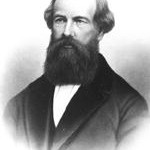Elisha Otis: The Father of the Elevator
 Elisha Otis was born close to Halifax Vermont in 1811. His mother and father ran a very successful farm and had deep roots in the New England area. At the age of 19 he left home and would eventually end up in Troy, New York. Otis spent five years living in Troy as a wagon driver and carpenter. In 1834 he wed a women named Susan Houghton. Shortly after the birth of his first son, Otis contracted a very serious case of pneumonia, which nearly killed him.
Elisha Otis was born close to Halifax Vermont in 1811. His mother and father ran a very successful farm and had deep roots in the New England area. At the age of 19 he left home and would eventually end up in Troy, New York. Otis spent five years living in Troy as a wagon driver and carpenter. In 1834 he wed a women named Susan Houghton. Shortly after the birth of his first son, Otis contracted a very serious case of pneumonia, which nearly killed him.
During the early years of his first marriage, Otis ran a freight hauling business that traveled between Troy and Brattleboro, Vermont. Despite falling seriously ill, Otis’s freight business was successful enough that he was able to purchase some land in an area called Green River, which was located near Brattleboro. His first wife, Susan Houghton, died in 1842, and left him two sons.
While at his Green River home, Otis had set up a gristmill and later a sawmill, but neither of these business ventures proved to be successful and in 1845, he moved back to New York. Otis would remain in Albany, New York for several years and married a women named Elizabeth Boyd.
Otis had always enjoyed tinkering with things and took a job as a mechanic at a factory that built heavy duty wooden matters frames. He opened up a small mechanics shop that he powered using a small creek near his home. Otis would invent one of his most important inventions, the turbine water wheel, at this shop. In 1851, the government in Albany decided to take control over the stream that Otis used to power his machine shop. He decided to take a mechanic job in New Jersey, which was offered to him by a contact he had made at the bed frame factory.
Shortly after Otis moved to New Jersey, his employer decided to build a new business in Yonkers, New York and sent Otis to oversee the construction of the factory. While in Yonkers, one of the biggest obstacles faced by Otis was the movement of building supplies between floors. He built several different types of rope hoists, which had been used for thousands of years and are basically dumbwaiters. One of the problem with a rope hoist is that if the rope breaks, whatever was being hoisted would come crashing to the ground.
Otis set out to solve this problem and developed several different designs that incorporated a safety catch, which in the event of a rope failure, would stop the car from falling. He eventually created a safety system which used used a very large spring and a set of sharp metal bars. If the rope broke, the spring would be released and the sharp metal bars would be propelled into the walls of the elevator shaft, bringing it quickly to a halt. Otis quickly moved onto other tasks as he was heavily involved in the construction of the new factory.
After the factory was constructed, Otis had been planning on heading to California to mine gold, but he began to receive many inquires about the lift he had built at the Yonkers factory. He quickly saw a market for his invention and created the E.G Otis Company. By 1854, Otis had developed the first passenger elevator, which he demonstrated at the Crystal Palace in New York. This elevator used a slightly different design which relied on a guided elevator system. A set of guide rails ran the length of the shaft the elevator was attached to the guide rails by a set of rollers. If the elevator began to fall too quickly, such as in the event of a cable failure, the rollers would engage and stop the elevator. The first Otis Safety elevator was installed in 1857 and was still in operation up until 1984.
In 1861, Otis was granted a patent for a special type of steam powered elevator. This patent was important because his elevator had its own steam engine. This allowed many businesses, many of which did not have their own power source, to install an elevator. Otis died later that year in 1861. His sons, Charles and Norton, took over their fathers business and continued to improve their fathers elevators. They developed a hydraulic elevator in the 1870’s, which was able to use city water. This hydraulic elevator could be installed in much larger building than the first Otis elevator, which was limited by the size of its cable system.
The legacy that Elisha Otis left for his sons can still be seen today. The Otis Elevator Company today employs over 65,000 people and is located in Connecticut. There are more than a million Otis elevators installed today and the company represents nearly a quarter of the elevator market.
Comments are off for this post